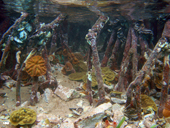ReefLink Database

Reef Life
Reef Life is the abundance, distribution, and condition of the biological components of the coral reef ecosystem. Stony coral, octocoral, algae, sponges and other species provide habitat for fish, invertebrates, and other inhabitants. Nearby wetlands are also an important component of the reef ecosystem, providing nursery habitat and refugia for many reef fish. Reef inhabitants, including fish & invertebrates, graze & maintain reef habitat, preventing overgrowth of algae. Microorganisms and invasive species can affect other reef species.
CMap

CMap Description
Changes in the abundance or condition of reef life have an impact on the health or well-being of humans through the provision of ecosystem services. Many reef species also provide supporting services that maintain the functioning of the ecosystem. Often the socio-economic drivers that benefit from the ecosystem are the same drivers that exert pressures on the ecosystem through their activities, including discharges of pollutants that alter the physical & chemical environment and contact uses that directly affect the survival, growth, & reproduction of reef life. Human activities can also introduce microorganisms and invasive Species into the reef ecosystem. Responses may seek to better understand or preserve reef life through monitoring or restoration activities.Citations
More than 50 citations. Click here to load.
| Citation | Year | Study Location | Study Type | Database Topics |
|---|
Management Options
More than 50 management options. Click here to load.
| Management Option | Description | Sources | Database Topics |
|---|
Laws
More than 50 laws. Click here to load.
| Legal Citation | Purpose of Law | Management Organization | Database Topics |
|---|
